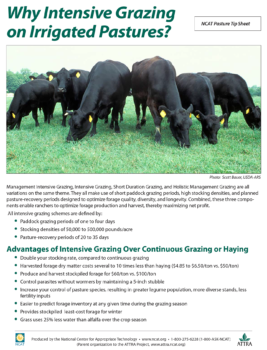Why Intensive Grazing on Irrigated Pastures?

Photo: Scott Bauer, USDA-ARS
NCAT Pasture Tipsheet Series
By Dave Scott, NCAT Livestock Specialist
Management Intensive Grazing, Intensive Grazing, Short Duration Grazing, and Holistic Management Grazing are all variations on the same theme. They all make use of short paddock grazing periods, high stocking densities, and planned
pasture-recovery periods designed to optimize forage quality, diversity, and longevity. Combined, these three components enable ranchers to optimize forage production and harvest, thereby maximizing net profit. All intensive grazing schemes are defined by:
- Paddock grazing periods of one to four days
- Stocking densities of 50,000 to 500,000 pounds/acre
- Pasture-recovery periods of 20 to 35 day
Advantages of Intensive Grazing Over Continuous
Grazing or Haying
- Double your stocking rate, compared to continuous grazing
- Harvested forage dry matter costs several to 10 times less than haying ($4.85 to $6.50/ton vs. $50/ton)
- Produce and harvest stockpiled forage for $60/ton vs. $100/ton
- Control parasites without wormers by maintaining a 5-inch stubble
- Increase your control of pasture species, resulting in greater legume population, more diverse stands, less fertility inputs
- Easier to predict forage inventory at any given time during the grazing season
- Provides stockpiled least-cost forage for winter
- Grass uses 25% less water than alfalfa over the crop season
Considerations
- Requires slightly more planning and management than other grazing systems or haying
- Increased labor—you are harvesting your crop (i.e., moving livestock) every day or two instead of every week or two
- Uses more temporary fencing than continuous or conventional rotational grazing
- Requires more fertility (mostly Nitrogen) than conventional grazing systems because of higher forage production
Will It Work for Me
- Am I willing to devote a little more time each day to management? Use of grazing charts will greatly simplify pasture and irrigation management.
- Always maintain a grass gradient or wedge. Look ahead. How many pounds of dry matter per acre did your grass produce the last week? How many pounds/acre are currently in the paddock where the stock will be one week from today? At the present growth rate, will there be enough forage to meet the grazing unit’s daily dry matter intake?
- Plan ahead to integrate irrigation with grazing. Know the available water-holding capacity of your soils; apply that moisture in a timely manner, using evapo-transpiration rates as a guide. See Further Resources for more information. Dust off your Paul Brown soil moisture probe and use it!
- Am I willing to allocate labor to move stock every one to four days?
Bottom Line
In the long run, intensive grazing is a proven management strategy to optimize profits. Intensive grazing decreases the forage harvesting costs by a factor of several to 10 times. It diverts investment capital from high-cost forage-harvesting equipment to livestock. Over time, livestock reproduce and appreciate in value. Haying machinery does not reproduce; it only breaks down.
The cost is your management time and labor. Give it some thought. Are you allocating your time to its best advantage?
Further Resources
- Pasture, Rangeland, and Adaptive Grazing Management
- Paddock Design, Fencing, Water Systems, and Livestock Movement Strategies for Multi-Paddock Grazing
- Nutrient Cycling in Pastures
United States Bureau of Reclamation, AGRIMET, Pacific Northwest Region. This resource provides comprehensive crops-related weather data throughout the Pacific
Northwest region.
The Great Plains Cooperative Agricultural Weather Network. U.S. Dept. of the Interior. This is the same crops-related weather data as above, except for east of the Continental Divide.
Why Intensive Grazing on Irrigated Pastures?
© 2013 National Center for Appropriate Technology—NCAT
By Dave Scott, NCAT Livestock Specialist
IP457
This publication is produced by the National Center for Appropriate Technology through the ATTRA Sustainable Agriculture program, under a cooperative agreement with USDA Rural Development. ATTRA.NCAT.ORG.


